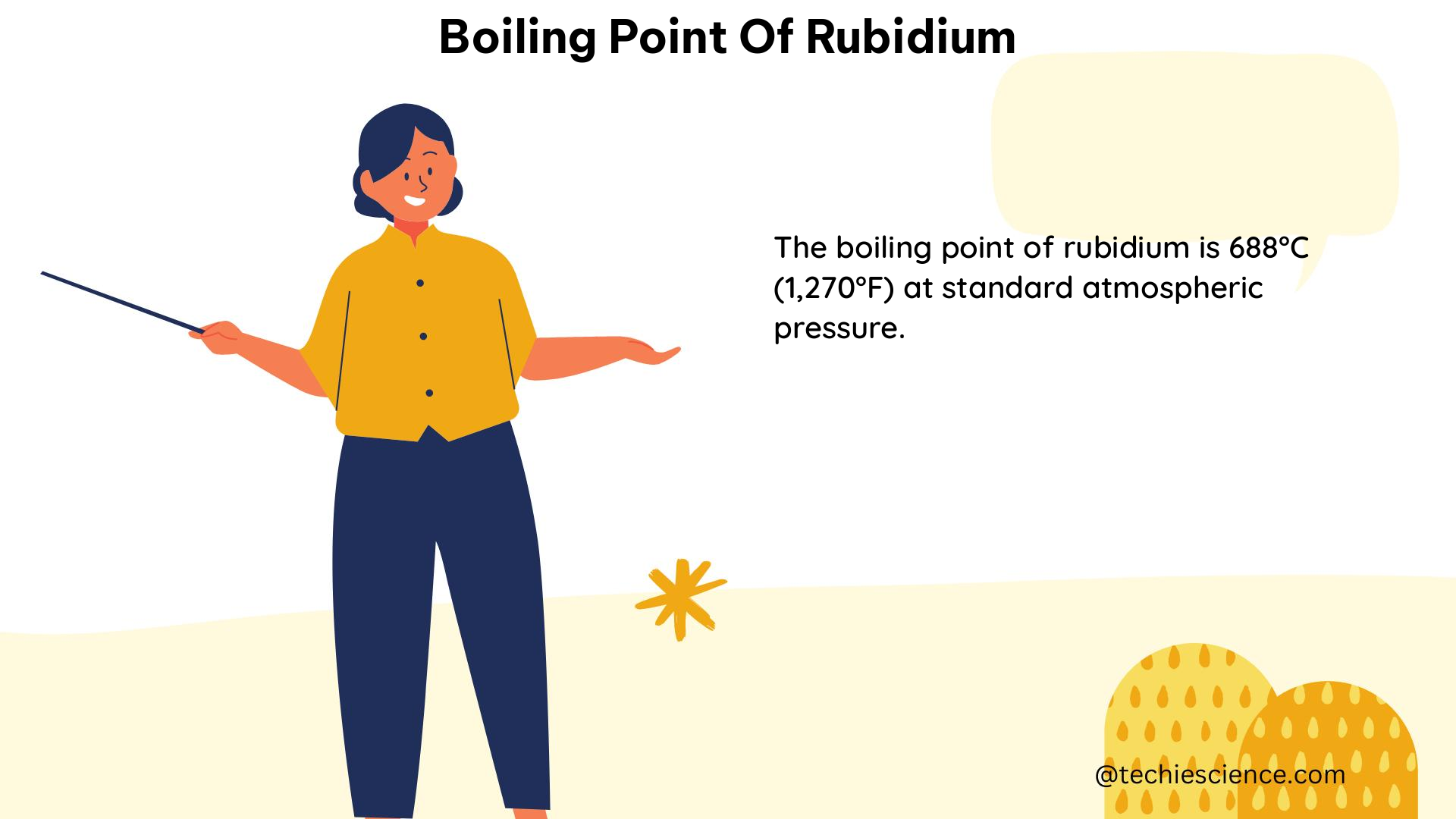The boiling point of rubidium, a highly reactive alkali metal, is a crucial physical property that has been extensively studied and documented. According to the National Institute of Standards and Technology (NIST), the boiling point of rubidium is 686 K or 413°C at standard atmospheric pressure (1 atmosphere or 101.3 kilopascals). This value is based on experimental measurements and is widely accepted in the scientific community.
Understanding the Clausius-Clapeyron Equation
To calculate the boiling point of rubidium, one can use the Clausius-Clapeyron equation, which relates the change in vapor pressure of a substance with temperature. The Clausius-Clapeyron equation is given by:
ln(P2/P1) = (ΔHvap/R) * (1/T1 - 1/T2)
Where:
– P1 and P2 are the vapor pressures at temperatures T1 and T2, respectively
– ΔHvap is the molar enthalpy (heat) of vaporization
– R is the universal gas constant
For rubidium, the heat of vaporization is 69.0 kJ/mol, and the entropy of vaporization is 71.9 J/mol·K at its boiling point (686 K or 413°C) and 1 atm pressure.
Factors Affecting the Boiling Point

The boiling point of a substance is a function of pressure, and therefore, the boiling point can vary depending on the ambient pressure. For example, at higher altitudes where the atmospheric pressure is lower, the boiling point of a substance will be lower than at sea level.
Pressure-Boiling Point Relationship
The relationship between pressure and boiling point can be expressed using the Clausius-Clapeyron equation. As the pressure decreases, the boiling point also decreases. This is because the vapor pressure of the substance must equal the surrounding pressure for boiling to occur.
For example, the boiling point of water at sea level (1 atm) is 100°C, but at the top of Mount Everest (where the pressure is about 0.3 atm), the boiling point of water is only around 71°C.
Altitude and Boiling Point
The boiling point of a substance is inversely proportional to the altitude or elevation above sea level. As the altitude increases, the atmospheric pressure decreases, leading to a lower boiling point.
The relationship between altitude and boiling point can be approximated using the following equation:
Tb = Tb0 - 0.0065h
Where:
– Tb is the boiling point at the given altitude (in °C)
– Tb0 is the boiling point at sea level (in °C)
– h is the altitude (in meters)
For rubidium, the boiling point at sea level is 413°C (686 K). At an altitude of 5,000 meters (approximately 16,400 feet), the boiling point of rubidium would be approximately 403°C (676 K).
Experimental Measurements and Data
The boiling point of rubidium has been measured experimentally using various techniques, and the results have been reported in the scientific literature. Here are some key data points:
| Property | Value |
|---|---|
| Boiling Point at 1 atm | 686 K (413°C) |
| Heat of Vaporization | 69.0 kJ/mol |
| Entropy of Vaporization | 71.9 J/mol·K |
These values are widely accepted and used in the scientific community for various applications, such as thermodynamic calculations, phase diagrams, and material properties.
Numerical Examples
Let’s consider a few numerical examples to illustrate the application of the Clausius-Clapeyron equation and the relationship between pressure and boiling point.
Example 1: Calculating the Boiling Point of Rubidium
Given:
– Heat of vaporization (ΔHvap) = 69.0 kJ/mol
– Entropy of vaporization (ΔSvap) = 71.9 J/mol·K
– Pressure (P) = 1 atm
Using the Clausius-Clapeyron equation, we can calculate the boiling point (Tb) of rubidium:
ln(P2/P1) = (ΔHvap/R) * (1/T1 - 1/T2)
ln(1 atm/1 atm) = (69,000 J/mol) / (8.314 J/mol·K) * (1/T1 - 1/Tb)
0 = 8,300 * (1/T1 - 1/Tb)
Tb = 686 K (413°C)
This result matches the widely accepted value for the boiling point of rubidium at standard atmospheric pressure.
Example 2: Boiling Point at High Altitude
Suppose we want to find the boiling point of rubidium at an altitude of 5,000 meters (approximately 16,400 feet).
Given:
– Boiling point at sea level (Tb0) = 413°C (686 K)
– Altitude (h) = 5,000 meters
Using the equation for the relationship between altitude and boiling point:
Tb = Tb0 - 0.0065h
Tb = 413°C - 0.0065 * 5,000 m
Tb = 403°C (676 K)
Therefore, the boiling point of rubidium at an altitude of 5,000 meters is approximately 403°C (676 K).
Conclusion
The boiling point of rubidium is a well-defined physical property that has been extensively studied and documented. By understanding the Clausius-Clapeyron equation and the factors that affect the boiling point, such as pressure and altitude, we can accurately calculate and predict the boiling point of rubidium under various conditions. The data and examples provided in this guide should serve as a comprehensive resource for students, researchers, and professionals working with rubidium and other alkali metals.
References
- Wikipedia. Absolute zero. https://en.wikipedia.org/wiki/Absolute_zero
- NIST. Melting Points and Boiling Points for the Alkali Metals. https://www.nist.gov/publications/melting-points-and-boiling-points-alkali-metals
- College Board. Chemistry Released Exam 1999. https://secure-media.collegeboard.org/apc/chemistry-released-exam-1999.pdf
- Study.com. Rubidium has a heat of vaporization of 69.0 kJ/mol and an entropy of vaporization of 71.9 J/K·mol. Calculate the boiling point of rubidium. https://homework.study.com/explanation/rubidium-has-a-heat-of-vaporization-of-69-0-kj-mol-and-an-entropy-of-vaporization-of-71-9-j-k-mol-calculate-the-boiling-point-of-rubidium-a-687-k-b-273-k-c-32-degrees-f-d-687-degrees-c.html
- NIST. Rubidium Triple-Point Standard. https://nvlpubs.nist.gov/nistpubs/Legacy/SP/nbsspecialpublication260-87.pdf

The lambdageeks.com Core SME Team is a group of experienced subject matter experts from diverse scientific and technical fields including Physics, Chemistry, Technology,Electronics & Electrical Engineering, Automotive, Mechanical Engineering. Our team collaborates to create high-quality, well-researched articles on a wide range of science and technology topics for the lambdageeks.com website.
All Our Senior SME are having more than 7 Years of experience in the respective fields . They are either Working Industry Professionals or assocaited With different Universities. Refer Our Authors Page to get to know About our Core SMEs.